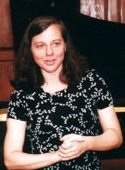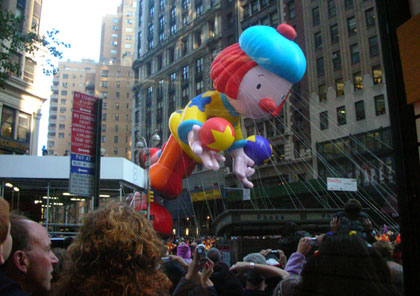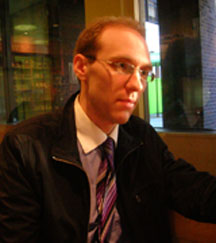Our regular listen to and look at living, breathing musicians that you may not know yet, but I know you should… And can, right here and now, since they’re nice enough to offer so much good listening online:
Julie Harting (b. 1957 — US, NYC)
 The talk is always “Oh that Schoenberg, making this artificial system that nobody really gets or feels!”… Except there are a few people like Julie:
The talk is always “Oh that Schoenberg, making this artificial system that nobody really gets or feels!”… Except there are a few people like Julie:
When I was 7 or 8, I found a miniature violin in my father’s closet, because he played violin when he was a kid. I also found a book called A Tune a Day, and I taught myself from the book to play a little violin, so it was clear that I was musical. But I ended up playing the tuba, but it was never really my instrument. It was really weird, loving music and being accomplished at it, but not playing an instrument that was mine. I ended up very depressed and confused, and when I was 18, after a year of college, I hitchhiked to Montreal with a friend. I was alone a lot, and one time when I was walking alone on a huge hill in the back of McGill University, I had this thought that at the time felt like it was coming from outside of me, that said I should compose. I took that and I said, “OK, that’s it.” It was my lifeline. After that, I went to Berklee College of Music in Boston, and then I finally got to Manhattan School of Music. […] But musically, Schoenberg is my big influence – his music and also his writings. Schoenberg’s also a person who’s very much concerned with integrity. It’s an inner journey when you compose, so you write the music that you feel is right, which means there’s kind of this morality to it, in a sense. You search for yourself, for what’s honest, and what’s truthful, and that’s what you write in music. Schoenberg’s such a key person for that, as well as Beethoven. Mahler’s great, too.
Maybe Julie’s music is “old school”; but if it is, I can happily go back there to study a little. It’s never a question of style so much as the voice, and Julie’s is a wonderfully distinct voice. At her site linked above, you can hear a number of her pieces; I’d particularly recommend the Trio for flute, cello and piano, and hoc est corpus meum for solo violin.
Samuel Vriezen (b. 1973 — Netherlands)
 Samuel posts around these parts, though infrequently enough that I feel OK about plugging him here. We’ve been bumping into each other for years on the USENET classical newsgroups, a happy breeze of true contemporary thinking amid all the John Williams wannabees and folk who haven’t gotten past Holst or even Yanni. From the rather complicated and involved pieces of his time in University, he’s been progressively paring back both his scores and materials; still finding the complicated and involved, but arising out of seemingly simple and clear actions and reactions. He’s also great Euro-advocate of our own expat composer, Tom Johnson, who pioneered many of these same concerns. Samuel also performs, and has helped produce a number of great exploratory concerts in Amsterdam over the years. His site linked above has plenty of listening, both to his own work and others equally interesting (Johnson included). If you’re ever headed to Amsterdam, he’s your hook-up, go-to guy.
Samuel posts around these parts, though infrequently enough that I feel OK about plugging him here. We’ve been bumping into each other for years on the USENET classical newsgroups, a happy breeze of true contemporary thinking amid all the John Williams wannabees and folk who haven’t gotten past Holst or even Yanni. From the rather complicated and involved pieces of his time in University, he’s been progressively paring back both his scores and materials; still finding the complicated and involved, but arising out of seemingly simple and clear actions and reactions. He’s also great Euro-advocate of our own expat composer, Tom Johnson, who pioneered many of these same concerns. Samuel also performs, and has helped produce a number of great exploratory concerts in Amsterdam over the years. His site linked above has plenty of listening, both to his own work and others equally interesting (Johnson included). If you’re ever headed to Amsterdam, he’s your hook-up, go-to guy.

 Here’s some great news for the Sequenza21 community. The super-hot Philadelphia-based chamber ensemble
Here’s some great news for the Sequenza21 community. The super-hot Philadelphia-based chamber ensemble  The talk is always “Oh that Schoenberg, making this artificial system that nobody really gets or feels!”… Except there are a few people like Julie:
The talk is always “Oh that Schoenberg, making this artificial system that nobody really gets or feels!”… Except there are a few people like Julie: Samuel posts around these parts, though infrequently enough that I feel OK about plugging him here. We’ve been bumping into each other for years on the USENET classical newsgroups, a happy breeze of true contemporary thinking amid all the John Williams wannabees and folk who haven’t gotten past Holst or even Yanni. From the rather complicated and involved pieces of his time in University, he’s been progressively paring back both his scores and materials; still finding the complicated and involved, but arising out of seemingly simple and clear actions and reactions. He’s also great Euro-advocate of our own expat composer, Tom Johnson, who pioneered many of these same concerns. Samuel also performs, and has helped produce a number of great exploratory concerts in Amsterdam over the years. His site linked above has plenty of listening, both to his own work and others equally interesting (Johnson included). If you’re ever headed to Amsterdam, he’s your hook-up, go-to guy.
Samuel posts around these parts, though infrequently enough that I feel OK about plugging him here. We’ve been bumping into each other for years on the USENET classical newsgroups, a happy breeze of true contemporary thinking amid all the John Williams wannabees and folk who haven’t gotten past Holst or even Yanni. From the rather complicated and involved pieces of his time in University, he’s been progressively paring back both his scores and materials; still finding the complicated and involved, but arising out of seemingly simple and clear actions and reactions. He’s also great Euro-advocate of our own expat composer, Tom Johnson, who pioneered many of these same concerns. Samuel also performs, and has helped produce a number of great exploratory concerts in Amsterdam over the years. His site linked above has plenty of listening, both to his own work and others equally interesting (Johnson included). If you’re ever headed to Amsterdam, he’s your hook-up, go-to guy.